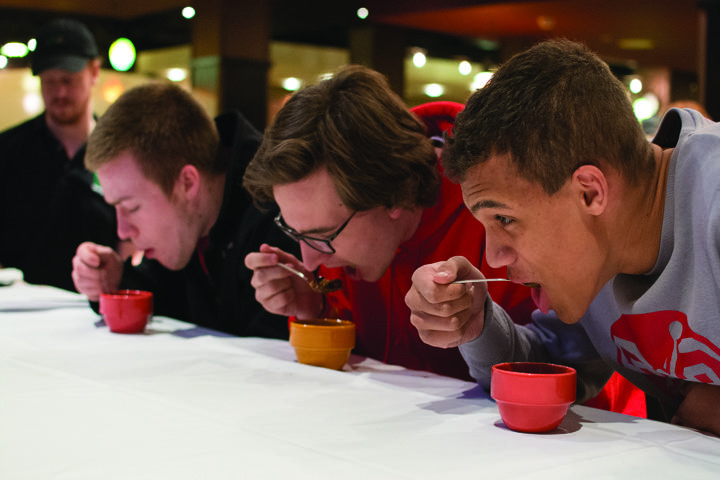Spicing up university dining centers
Students (left to right) Alex Kenemore, Dylan Sullivan and Adarius Hopkins participate in the Terrace Dining Center chili challenge. Photo by Nick Nelson/The Dakota Student.
Pyro-gourmaniacs, or spicy food lovers, have been flocking to the campus dining centers this week to compete in the Chili Challenge.
Participants were given two minutes to eat a small bowl of chili, and had to attend the contest every day of the week. Each day, students were given an increasingly challenging dish to consume.
“The chili is supposed to get progressively spicier throughout the week,” student manager Anna Claire Tandberg said.
By the second day of the event, it was clear that students were already dropping like flies.
“We went from having 58 people on Monday to less than 40 on Tuesday,” Tandberg said.
Along with the spiciness of the dishes, students were allegedly thrown an extra obstacle with Monday’s chili.
“The first day’s chili wasn’t very spicy, but the temperature was really high,” freshman Travis Novey said. “It’s a lot easier when it’s not boiling hot like it was on Monday.”
The motivation for many behind ingesting the increasingly spicy dishes is the opportunity to receive a coveted Chili Challenge T-shirt, which is awarded to everyone that can eat each day’s chili.
“My girlfriend bet me that I couldn’t take the heat,” freshman Alex Horrand said. “But I’m not doing this for her. I’m not even doing this for me. I’m doing this for the t-shirt.”
Facts about spicy food
1) The chemical that gives chilies their spicy flavor, capsaicin, causes the body to release endorphins. Endorphins reduce the perception of pain while simultaneously producing a feeling of elation.
2) Capsaicin is the main ingredient found in pepper spray. No studies show that capsaicin causes the feeling of elation when applied to the eyes.
3) The hottest known pepper in the world is the aptly named Carolina Reaper, which is a hybrid between a ghost pepper and a red habanero pepper. It scores up to 2.2 million Scoville ccale, which is actually higher than some commercially available pepper spray. Jalapeno peppers average between 1,000 and 2,500 Scoville units, in comparison.
4) Though it may sound counter intuitive, eating spicy foods on a hot day can actually cool you off. After eating something spicy, internal body temperature is raised. The body then produces an excess of sweat, cooling you down.
5) The best options to soothe the burning spicy food are dairy products, peanut butter, and honey. Water and pop are among the worst reliefs, because they are water based and do not help neutralize the fiery capsaicin.
Information provided byabcnews.com, crazyhotseeds.com, huffingtonpost.com and pepperscale.com.
Brendan McCabe is a staff writer for The Dakota Student. He can be reached at [email protected].















